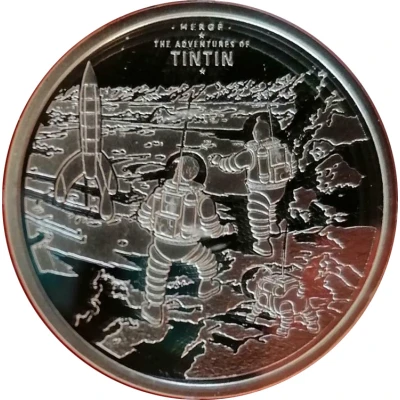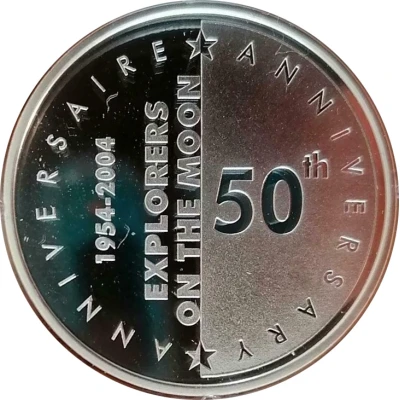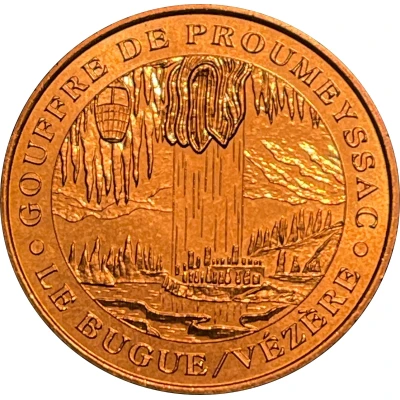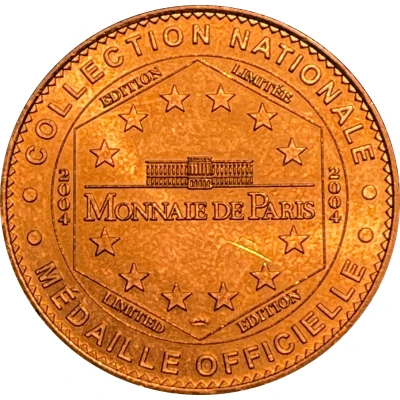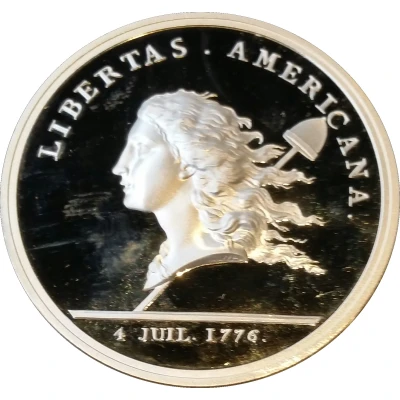
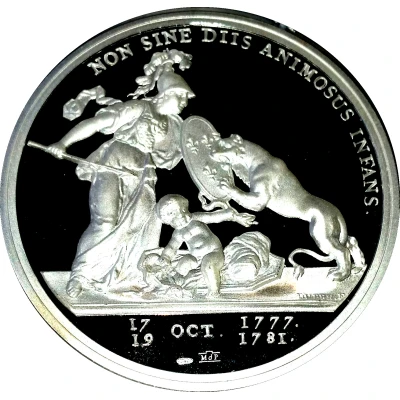

Medal - Libertas Americana Silver 2004 Restrike Proof ND
2004 year| Silver (.999) | 24 g | 40 mm |
| Location | France |
|---|---|
| Type | Medals › Coin replicas |
| Year | 2004 |
| Composition | Silver (.999) |
| Weight | 24 g |
| Diameter | 40 mm |
| Shape | Round |
| Technique | Milled |
| Orientation | Medal alignment ↑↑ |
| Updated | 2024-11-12 |
| Numista | N#83605 |
|---|---|
| Rarity index | 94% |
Reverse
America is depicted as an infant Hercules, strangling two serpents representing the armies of Burgoyne and Cornwallis. He is defended by France, represented as the warrior-goddess Minerva, clad in breastplate and plumed helmet, holding a shield bearing the fleurs de lys of France. She fends off the British lion, which stands with its forepaws upon her shield, its tail between its rear legs, a heraldic symbol of defeat.
Dates in exergue.
Script: Latin
Lettering:
NON SINE DIIS ANIMOSUS INFANS.
DUPRE
____________
17 1777.
OCT.
19 1781.
999 M d P
Engraver: Augustin Dupré
Edge
Plain
Comment
The Original Medal and its History
Libertas Americana
http://www.usrarecoininvestments.com/coin_info/colonial_coins/libertas_americana.htm
The most famous of all American medals is the elegant Libertas Americana (''American Liberty'') medal. It celebrates America's Revolutionary War military victories, specifically the British surrenders at Saratoga (1777) and Yorktown (1781). Benjamin Franklin conceived the idea, as a private project to enhance Franco-American goodwill.
In a letter dated March 4, 1782, Franklin wrote from Paris:
''This puts me in mind of a medal I have had a mind to strike, since the late great event you gave me an account of, representing the United States by the figure of an infant Hercules in his cradle, strangling the two serpents; and France by that of Minerva, sitting by as his nurse, with her spear and helmet, and her robe specked with a few fleurs de lys. The extinguishing of two entire armies in one war is what has rarely happened, and it gives a presage of the future force of our growing empire.''
A preliminary sketch was drawn by painter Esprit-Antoine Giblein, and the dies were engraved by Augustin Dupré. The medals were struck at the Paris Mint in 1783, with two specimens struck in gold for presentation to the King and Queen of France. A few others were struck in silver, and the rest in copper.
In a letter dated April 15, 1783, Franklin wrote:
''I have caused to be struck here the medal which I formerly mentioned to you, the design of which you seemed to approve. I enclose one of them in silver, for the President of Congress, and one in copper for yourself; the impression in copper is thought to appear best, and you will soon receive a number for the members. I have presented one to the King, and another to the Queen, both in gold, and one in silver to each of the ministers, as a monumental acknowledgment, which may go down to future ages, of the obligations we are under to this nation. It is mighty well received, and gives general pleasure.''
A September 13, 1783 letter from Franklin to the President of the United States Congress added: ''I am happy to hear that both the device and workmanship of the medal are approved with you, as they have the good fortune to be by the best judges on this side of the water. It has been esteemed a well-timed, as well as a well-merited, compliment here, and has its good effects. Since the two first which you mention as received, I have sent by different opportunities so many, as that every member of Congress might have one. I hope they are come safe to hand by this time.''
Dupré probably created the obverse portrait of Liberty, with her hair flowing freely in the wind, superimposed on a pole topped by a pileus, the helmet-like emblem of freedom. The design symbolized both freedom from slavery, and America's freedom from George III of England.
The assistance of France was invaluable in the triumph over England during the Revolutionary War, and the allegorical reverse design commemorates the struggle. America is depicted as an infant Hercules, strangling two serpents representing the armies of Burgoyne and Cornwallis. He is defended by France, represented as the warrior-goddess Minerva, clad in breastplate and plumed helmet, holding a shield bearing the fleurs de lys of France. She fends off the British lion, which stands with its forepaws upon her shield, its tail between its rear legs, a heraldic symbol of defeat. The dates in the exergue refer to the surrenders of Burgoyne at Saratoga and Cornwallis at Yorktown. The Latin inscription NON SINE DIIS ANIMOSUS INFANS translates as ''the infant is not bold without divine aid.''
From Malta's US Embassy website:
In 1783, Benjamin Franklin, in his capacity as U.S. Ambassador to France, designed and minted America’s first medal “Libertas Americana.” Franklin gave all but one medal to French officials and members of the U.S. Congress. The sole medal given to another foreign official was a medal presented by Franklin to Grand Master Emmanuel de Rohan.
Franklin sent the medal to Grandmaster de Rohan specifically to thank him for his support. In the letter that accompanied the medal, Franklin wrote, “I have the honor to address to Your Emminent Highness the medal which I have lately had struck. It is an Homage of gratitude, my Lord, which is due to the interest you have taken in our cause; and we no less owe it to your virtues and to your eminent highness wise administration of government.” Franklin also asked that the Grandmaster allow American ships to come to Maltese ports.
Grandmaster de Rohan replied quickly and positively. In his response, de Rohan wrote, “This monument of American liberty has a distinguished place in my cabinet. Whenever chance or commerce shall lead any of your citizens or their vessels into the ports of my island, I shall receive them with the greatest welcome.”
So began, 223 years ago, diplomatic relations between the United States in Malta. Unfortunately the original letter from Franklin and medal has not been located, despite thorough searches in the National Archives in Valletta. However, the letter from de Rohan to Franklin still exists and is located in Philadelphia in the American Philosophical Society. http://www.usrarecoininvestments.com/coin_info/colonial_coins/libertas_americana.htm
(from Stack's:) http://legacy.stacks.com/Lot/ItemDetail/105999
Numismatic scholar John Adams and Massachusetts Historical Society curator Anne Bentley, who is the caretaker of the silver Libertas Americana medal that Jefferson presented to Washington in 1790, have recently completed a thorough accounting of known specimens of this and the similar Comitia Americana series. We look forward to their census, and until its publication we would estimate that perhaps two dozen or so exist, the vast majority of which are in institutional collections. The Libertas Americana medal is most famously associated with Benjamin Franklin, as the designs and legends were the result of his collaboration with other top minds of his era: Robert Livingston, who offered early encouragement; Sir William Jones, the Englishman who suggested a line from Horace be used as the reverse legend; fresco painter E.A. Gibelin, who was the first to sketch Franklin's conception. Of course, it was Franklin's friendship with the top French sculptor of the period, Augustin Dupre, that made the Libertas Americana medal an exceptionally beautiful monument to the American Liberty they both held in great esteem. Guided by Franklin's influence, it was Dupre who conceived the beautiful face of Liberty with flowing tresses that came to be the instantly identifiable face of the new nation. Franklin was very pleased with his creation. He found that Sir William Jones' suggestion for a reverse legend, translated as "The courageous child was aided by the Gods," was perfectly applicable. It was probably Franklin's idea to show the lion, representing Great Britain, with its tail between its legs. When he wrote to Robert Livingston, who served with Franklin on the committee to create the Declaration of Independence, on April 15, 1783, he reported general satisfaction with the design: "it is mightily well received, and gives general pleasure." He also included a specimen in silver for "the President of Congress" and mentioned that he presented "one in silver to each of the French ministers, as a monumental acknowledgement, which may go down in future ages, of the obligations we are under to this nation." When this letter was written, the President of Congress and the recipient of a silver medal precisely like the one offered here was none other than Elias Boudinot of New Jersey, the man who would become Director of the Mint in 1795. As noted above, Washington also received a silver specimen, Jefferson displayed a specimen at his home (composition unknown), and undoubtedly many men of similar stature in both Europe and America likewise were given specimens in silver. Washington's was included in a set of Comitia Americana medals, and Jefferson may have intended to include Libertas Americana medals in the sets that Congress "directed me to present ... to the different powers of Europe, to the universities of Europe, to certain officers there ..." Indeed, many remain in institutional collections, and silver specimens enter the market only occasionally.
